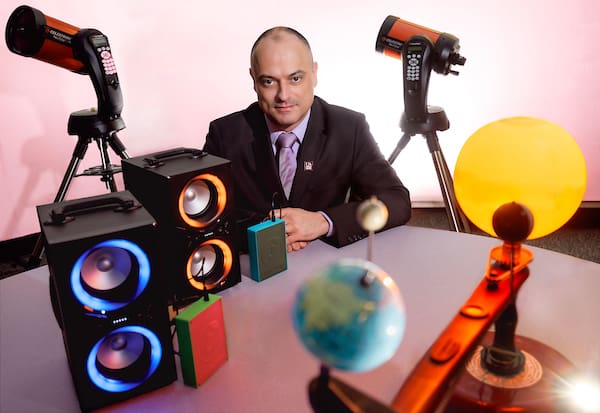Inclusive Eclipse Experience: UA Little Rock Solar Eclipse Celebrate to Include Innovative Devices for Blind and Low Vision Community

The UA Little Rock Solar Eclipse Celebration on April 8 will include two devices designed to provide a unique auditory experience for the Blind and Low Vision community.
UA Little Rock will have two LightSound devices that will enable individuals with visual impairments to experience the solar eclipse through sound. The two devices are provided by the LightSound Project at Harvard University, who are distributing these devices for use at universities, schools, and nonprofits across the country during the solar eclipse on April 8.
UA Little Rock will welcome the public and campus community to experience this rare and breathtaking event on campus. This day of science and observation for the whole family will take place from 10 a.m. – 4 p.m. Monday, April 8, with activities taking place both inside and outside the Jack Stephens Center.
Dr. Gregory Guisbiers, associate professor of physics and astronomy, said he requested to have the LightSound devices at UA Little Rock because he wanted to have a welcoming and inclusive event where everyone could enjoy the solar eclipse.
“UA Little Rock is one of the few places in Arkansas who will have LightSound devices available for public use during the solar eclipse,” Guisbiers said. “This is a celebration where we want everyone to feel included. The LightSound devices are one way that we are helping everyone to enjoy the total solar eclipse.”
The LightSound prototype was developed for the 2017 solar eclipse as a tool for the Blind and Low Vision community to experience a solar eclipse with sound. The device uses a technique called sonification, which is the process of converting data (or light intensity in this case) to sound.
As the moon eclipses the sun during a solar eclipse, the sunlight begins to dim, and the LightSound device will output a change in musical tone. The device can be attached to headphones or to a speaker to project the sound for a group.
The device was first used during the 2017 solar eclipse in Jackson Hole, Wyoming, Morehead State University, and the Kentucky School for the Blind. The LightSound Project has a goal of building 750 devices for the April solar eclipse and has donated more than 200 devices.
UA Little Rock’s event is funded by the Donaghey Foundation, Arkansas Space Grant Consortium, and the UA Little Rock Donaghey College of Science, Technology, Engineering, and Math. For more information on UA Little Rock’s solar eclipse event, visit ualr.edu/eclipse.
